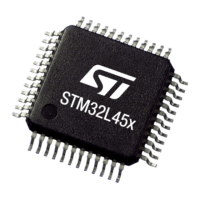SM CODE CLK_SM_2
Recommendations and known limitations The adoption of an external watchdog (refer to CPU_SM_5) adds further diversity.
Table 43. CLK_SM_3
SM CODE CLK_SM_3
Description Internal clock cross-measurement
Ownership End user
Detailed implementation
This method is implemented using TIM15/TIM16/TIM17 capabilities to be fed by the 32 KHz
RTC clock or an external clock source (if available). TIM15/TIM16/TIM17 counter progresses
are compared with another counter (fed by internal clock). Abnormal values of oscillator
frequency can therefore be detected.
Error reporting Depends on implementation
Fault detection time Depends on implementation
Addressed fault model Permanent
Dependency on Device configuration None
Initialization Depends on implementation
Periodicity Periodic
Test for the diagnostic Not applicable
Multiple-fault protection
CPU_SM_1: Control flow monitoring in Application software
CPU_SM_5: External watchdog
Recommendations and known limitations
Efficiency versus transient faults is negligible. It provides only medium efficiency in permanent
clock-related failure mode coverage.
3.6.8 General-purpose input/output (GPIO)
Table 44. GPIO_SM_0
SM CODE GPIO_SM_0
Description Periodic read-back of configuration registers
Ownership End user
Detailed implementation
This method must be applied to GPIO configuration registers.
Detailed information on the implementation of this method can be found in
Section 3.6.14 Extended interrupt and events controller (EXTI).
Error reporting Refer to NVIC_SM_0
Fault detection time Refer to NVIC_SM_0
Addressed fault model Refer to NVIC_SM_0
Dependency on Device configuration GPIO availability can differ according to part number
Initialization Refer to NVIC_SM_0
Periodicity Refer to NVIC_SM_0
Test for the diagnostic Refer to NVIC_SM_0
Multiple-fault protection Refer to NVIC_SM_0
Recommendations and known limitations Refer to NVIC_SM_0
UM2305
Hardware and software diagnostics
UM2305 - Rev 10
page 31/110

